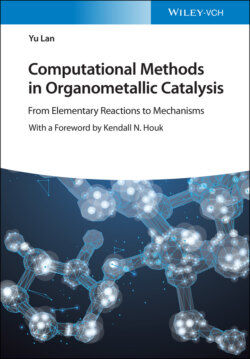Читать книгу Computational Methods in Organometallic Catalysis - Yu Lan - Страница 17
1.2.1 Mechanism of Transition Metal Catalysis
ОглавлениеGenerally, reaction mechanism could be considered to be all elementary reactions used to describe a chemical change passing in a reaction. It is to decompose a complex reaction into several elementary reactions and then combine them according to certain rules, so as to expound the internal relations of complex reactions and the internal relations between total reactions and elementary reactions. The rate of chemical reaction is closely related to the specific pathways through which the reaction takes place.
To study the law of chemical reaction rate and find out the intrinsic causes of various chemical reaction rates, synthetic chemists must explore the reaction mechanism and find out the key to determine the reaction rate, so as to control the chemical reaction rate more effectively. As shown in Scheme 1.4, traditional research methods for reaction mechanism include: (i) determining the important intermediate or decisive step of a reaction by isotope tracing, (ii) determining the effect of different factors (e.g. reaction temperature, solvent, substituent effect, etc.) on reaction rate and selectivity by competitive test, (iii) studying the relationship between the reaction rate and the concentration of reactants and catalysts obtaining by kinetic experiments, and (iv) characterizing and tracking intermediates by instrumental analysis. However, these methods are often macroscopic observation of the average state of many molecules, which cannot watch a process of the transformation for one molecule from a micro‐perspective. Fortunately, theoretical calculations based on first principles have become one of the important means to study the reaction mechanism with the development of software and the improvement of hardware computing capability in recent several decades. Through theoretical calculation and simulation, the transformation of one molecule in reaction process can be “watched” more clearly from the microscopic point of view. Actually, theoretical calculation can be considered to be a special kind of microscope, which can see the geometrical structure, electronic structure, spectrum, and dynamic process at atomic level, and is helpful for chemists to understand the real reaction mechanism.
Scheme 1.4 Revealing the reaction mechanism of organometallic catalysis.
The combination of theoretical and experimental techniques could not only greatly improve the efficiency of reaction and yield of product, but also uncover the factors that control the selectivity of product more clearly. The promotion of theoretical study to experimental investigation could be summarized into “3D,” i.e. description, design, and direction. Based on the data obtained from experimental technique, detailed description for the mechanism of organometallic catalysis could be fulfilled using theoretical calculations. Based on the results of computations, the mechanisms could be verified by the designed experiment. To put in a nutshell, theoretical calculations could play a critical role in the direction of transition‐metal‐organic synthesis.
